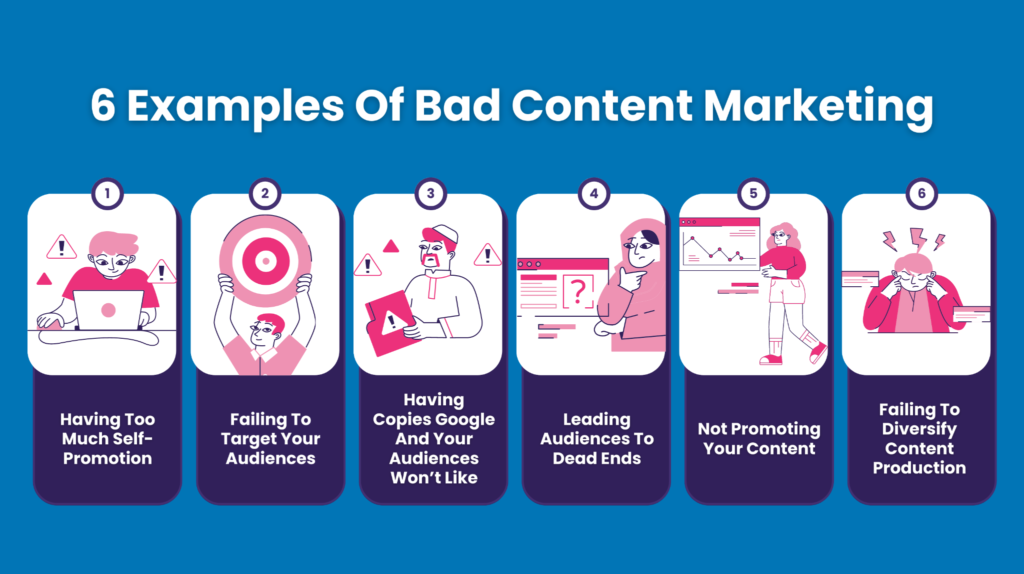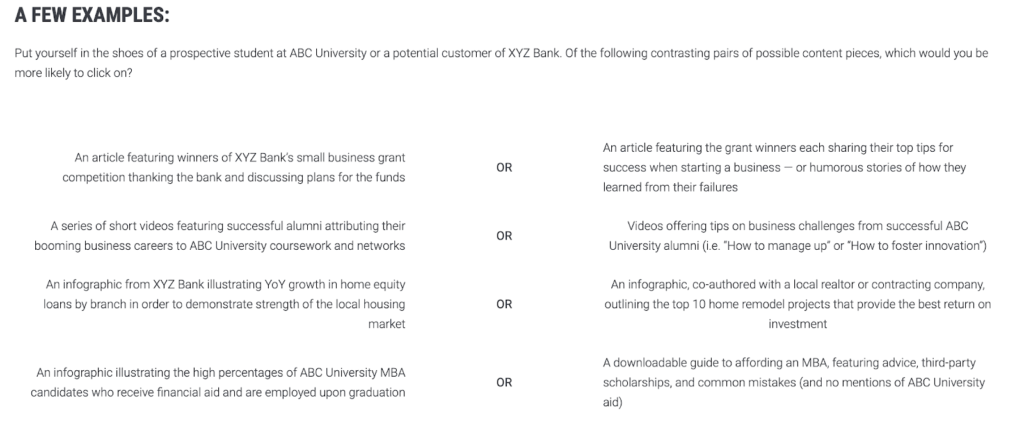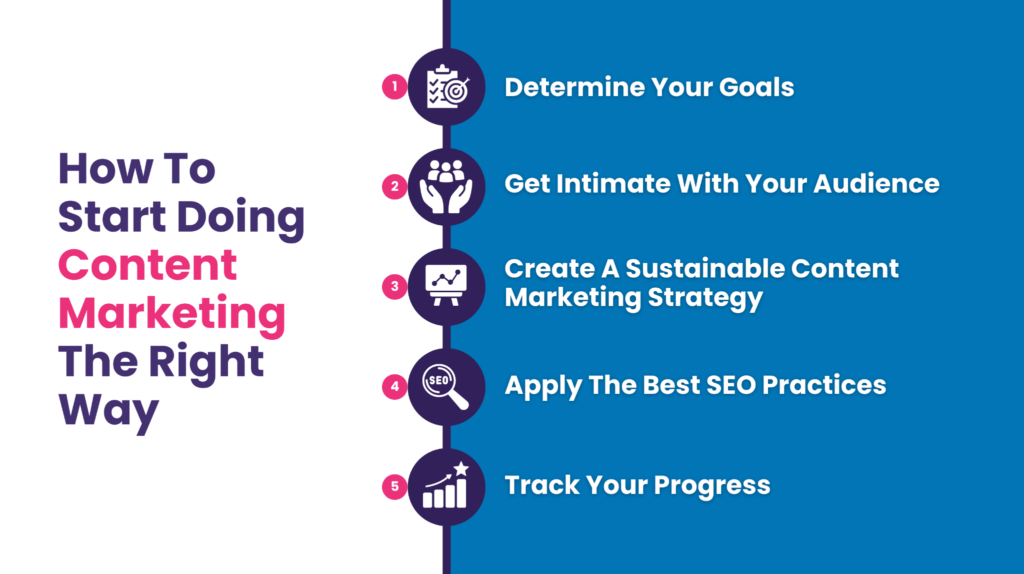Menu

Content marketing can drive growth into your business by establishing your credibility and building a strong relationship with different audiences, attracting potential customers. While digital marketing is a cost and time-efficient option for boosting your brand, it can still be an elaborate approach with many aspects to ensure. That's why many businesses still make content marketing mistakes that do more harm than good to your brand.
So what are some of the bad content marketing examples? The common mistakes many content marketers make are promoting their brand way too much, failing to connect with their target audience, creating bad content, leading consumers to dead ends, failing to promote content, and lacking diversity in content creation. They tend to make these same mistakes due to a lack of a sustainable content marketing strategy and research on their consumers.
Many content marketers fail to develop a deeper understanding of the processes of content marketing strategies, usually because they're still starting with their campaign or they lack thorough research and planning. This makes them at risk of having content marketing mistakes, like:

One of the common mistakes in content marketing is talking about your product or service too much in blog posts and other content marketing efforts. Forge Worldwide provided a few examples of this mistake:

Source: Forge Worldwide
The content on the left only promotes the brand’s product or service and even prestige, while the topics on the right demonstrate their expertise by posting pieces with valuable information to their readers. More users are likely to be engaged with the content on the right because it appeals to their needs and interest in the industry.
Digital marketing aims to boost your brand awareness and fulfill other business goals, so some find it counterintuitive not to promote your product or service too much. But with content marketing, you should focus on what users want or need by producing relevant and high-quality content. An audience visiting a blog post to seek solutions to problems doesn't want to find a copy full of self-promotion.
Since content marketing is about creating content to provide relevant and valuable information to users, you should get intimate with your target audience to gain a deeper understanding of their behavior, interests, and concerns. Failing to target audiences in your social media posts, blogs, and other forms of content is a common mistake or hurdle in content marketing.
Lacking research on your audiences affects the quality and relevance of the content you produce, from the topics you talk about to the language you speak. You won't be able to maximize the resources spent on content creation if you fail to connect with your audiences.
At worst, you may make the same mistake as Walmart did. When they released their line of Halloween costumes in 2014, they called the costumes for plus-sized women, "Fat Girl Costumes." They may have run into this mistake due to a lack of understanding of different target audiences, making them produce a copy lacking sensitivity.
But the good news is you can avoid or overcome this problem by creating a detailed buyer persona from the information you've gathered from your research.
You must write blog posts and other types of content with the utmost expertise, from observing proper grammar and syntax to keeping them engaging. Ensure applying the best SEO practices, like the proper placement of keywords and supporting your content with hyperlinks.
While this has been a common understanding among content marketers, many businesses still fail to produce great content. Some lose sight of user experience and its connection to SEO. Keyword stuffing is the bad practice of adding many keywords that make your content sound unnatural.
Pages with bad content rank poorly on search engine results pages or SERPs, as the Google algorithm picks up user behavior with bad content. Unsatisfied visitors tend to leave the page immediately, resulting in high bounce rates. And because search engine algorithms have booted you to the bottom of the SERPs, your page also gets low traffic.

Source: protocol 80, Inc.
The photo above shows an example of a poorly written and formatted blog post. The text is not optimized for user experience and search engine algorithms because of being broken into subsections with only minimal bulleted lists. Audiences won’t get engaged with these types of blogs that are overwhelming to read, especially when their attention spans tend to bounce quickly.
Content marketing allows you to connect to your audiences and build, converting them into loyal customers. This is why content marketers must guide users in taking the next step or performing desired actions. An example of this mistake is visiting a company’s web page and not knowing what to do next.
Every page on your website must clearly state a goal and guide visitors on what they can do next. That’s why you must have a cohesive content strategy that also sees through the stages of a buyer's journey. Knowing these stages allows you to lead users seamlessly until they reach their destination and perform profitable consumer actions.
You can do this by complementing great content with a strong and clear call to action. A good call-to-action helps an audience decide on the next step once engaged with your content. Your CTA must be brief, clear, and urgent, so you should use powerful verbs. All the content you produce must have a good CTA, whether it's a blog post, website service page, or social media post. If you're doing email marketing, you might not want to forget this in your newsletters.
Failing to promote your content is also an example of poor content marketing practices. You may have written an informative and authoritative blog post, but not promoting it enough may put it to waste, having the post end up with low traffic and engagement. Good content marketing strategies plan content creation from ideation to promotion -- this allows you to get the most out of the pieces you create, ensuring it reaches a broader audience.
For starters, ensure informing your audiences about the blog posts, YouTube videos, or other types of content you've released. You can promote these on your social media accounts or send emails to your subscribers if you also engage in email marketing. Other publications and websites can also help share your content. You can create interesting and creative campaigns to promote your content and reach a broader audience.
A winning content marketing strategy must also have a long-term perspective of your brand and its establishment as a thought leader. If you're just about to start boosting your company online, it makes sense to produce content twice a week or even less in some situations.
But you might not want to keep your progress stagnant and settle for the same framework for long -- you might want to get more creative and explore other types of content that highlight your value, like:
Consider repurposing your content, so you won't create one from scratch for every scheduled post. Diversifying content also involves determining what every buyer persona needs and defining the best type of content to use.
Content marketing is a cost-efficient option to boost your brand and drive growth in your business. But not doing it right by writing or publishing bad content can hurt your online presence, resulting in:
Some businesses tend to fall into the traps of poor content marketing practices that affect their brand negatively. Here are some of the possible reasons why you might encounter this hurdle:
These are only some common reasons businesses incorporate poor strategies without knowing them, resulting in bad examples of content marketing. Keeping these practices up may hurt your brand reputation in the long run and may cause more audiences to turn away from you. The good thing is that you can still resolve these problems and do significant changes in your content marketing processes.
A content marketer would know if the content they produce holds little to no value for their target audience by reviewing their analytics -- that's why brands need to track and assess their analytics consistently. Some of the signs of having bad content are:
These are the common signs or metrics that signal to have bad content. That’s why you must assess these numbers regularly to determine if your content strategy still works for you.
If you’re one of the brands with bad practices in content marketing, you can still do several things to boost your online presence strategically. It’s never too late to implement the most suitable resolutions, even if it means going back to the basics. This can set you up for success in finally establishing your brand as a thought leader and driving growth to your brand.

One of the first steps in recalibrating your content marketing efforts is to define your goals. After determining your market position and identifying the roadblocks in your campaigns, set clear objectives for resolving them. This allows you to set your online presence up for success in thought leadership.
Defining your goals gives you a clear direction for your content marketing efforts. This helps you create more cohesive campaigns that contribute collectively to your objectives. Even if you’re still starting, you might still want to determine your long-term goals to ensure that your short-term objectives contribute to them.
As established, the content you produce must appeal to your audience, so it must resonate with their challenges, interests, or needs. Because of this, doing extensive research on your target audience and getting intimate with them can give you valuable insights into creating content. This allows you to pitch great topics and write engaging content. To know more about your audience, you can:
Once you’ve understood who your audiences are, you might want to document these findings and develop detailed buyer personas. These will help you keep your content marketing strategies and campaigns aligned with your audiences.
Many bad practices of content marketing come from the lack of a sustainable strategy, making your campaigns arbitrary and short-sighted. To set your content marketing efforts in motion, you might want to start by developing a content marketing framework that sees through your growth long-term, allowing every campaign to contribute to your overall goal. You can do this by:
While prioritizing user-centric content, you might still want to apply the best SEO practices for your website to mature more quickly and set your pages up for success in gaining high rankings on SERPs. Incorporating advanced SEO strategies into your content allows you to gain a better relationship with Google and other search engines. These strategies include:
These are some recommended SEO strategies you may want to incorporate into your content marketing efforts. These practices greatly boost your content maturation and result in your pages landing high rankings on SERPs.
Most, if not all, businesses also make mistakes when executing their content marketing campaigns. This can happen sometimes when a specific strategy turns out to be incompatible with their business at the given time. That’s why businesses should monitor and assess their performance to detect and resolve roadblocks immediately.
Identify key metrics to track and gain data-based insights on your performance. These gauges can also tell you if your current strategy is working well. You can check out tools like Google Analytics to help you gather these numbers.
Content marketing tends to involve elaborate strategies for boosting your online presence and establishing trust among your target audience to prompt profitable consumer actions. That’s why it no longer comes as a surprise that many brands get their fair share of bad examples of content marketing.
Some examples of bad digital marketing are promoting your brand too much, failing to address your target audiences, and producing bad content. You should also guide your consumers through their buying journey and avoid too much self-promotion of your content. Ensure diversifying your content to promote the growth of your online presence.
